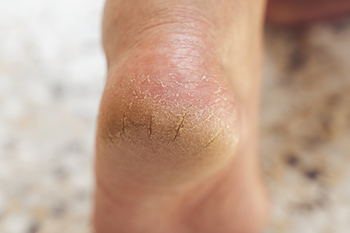Connect With Us
Blog
Items filtered by date: December 2023
Managing Cracked Heels

Cracked heels, or heel fissures, can be a bothersome foot condition that requires attention. While most people associate cracked heels with summer weather, they can also be problematic during the winter. Cracked heels often stem from hardened and dry skin, often accompanied by thick calluses. While standard moisturizers or petroleum jelly can offer relief, persistent cracks may indicate more profound issues. In fact, athlete's foot, a fungal infection typically causing itchiness and scaling, can migrate to the heels, leading to painful fissures. For mild cases, regular moisturizing, especially during dry winter months, can be beneficial. If at-home solutions prove ineffective, consulting a chiropodist is important. Severe cases can result in infections such as cellulitis, underscoring the importance of prompt and appropriate care. Cracked heels may also signal deeper health problems, such as hypothyroidism, diabetes, or heel bone spurs. Maintaining smooth and crack-free heels involves proper foot care, awareness of potential causes, and seeking guidance when needed. If cracks persist, it is suggested that you schedule an appointment with a chiropodist for a full evaluation and treatment options.
Dry, cracked heels are more than a cosmetic inconvenience. For many people, they are uncomfortable, deep, painful, and may even bleed. If you suffer from cracked heels, please consult with one of our chiropodists from West Toronto Foot & Ankle Clinic Inc. . Our chiropodist can help you maintain the health of your lower limbs and your mobility.
Causes
- Prolonged standing
- Wearing open-back shoes
- Wearing shoes that don’t cushion the heels
- Living in a cold or dry climate
- Taking long, hot showers
- Not moisturizing the heels
- Eczema
- Psoriasis
- Palmoplantar keratoderma
- Juvenile plantar dermatosis
Treatments
- Soaking the feet
- Exfoliating with a pumice stone
- Moisturizing the heels
- Wearing closed-back shoes that cushion heels
- Avoiding prolonged standing
- Taking warm, rather than hot, showers
- Treating underlying skin conditions
While milder cases of cracked heels can be treated at home, some patients present with deep, painful, bleeding heel fissures that are at risk of becoming infected and may require medical care. Additionally, patients with diabetes or any other conditions that affect the immune system should be monitored by a chiropodist.
If you have any questions, please feel free to contact our office located in . We offer the newest diagnostic and treatment technologies for all your foot care needs.
Baseball Injuries Affecting the Feet and Ankles

Baseball can be a thrilling sport, but it carries the risk of foot and ankle injuries. Ankle sprains are common due to sudden direction changes and sliding, and severe sprains may require a wearing cast or boot. Overuse can lead to Achilles tendonitis, and more complex injuries may need immobilization or even surgery. Plantar fasciitis causes heel pain and can hinder mobility. Repetitive impact can result in stress fractures. Properly fitted shoes can prevent cleat blisters, and blister care may help to prevent these painful nuisances. If you are experiencing any of these uncomfortable injuries from playing baseball, it is suggested that you schedule an appointment with a chiropodist for an accurate diagnosis and treatment that will ensure a return to the sport as quickly as possible.
Injuries to the foot and ankle are very common among athletes. If you have experienced an injury, please consult with one of our chiropodists from West Toronto Foot & Ankle Clinic Inc. . Our chiropodist will assess your condition and provide you with quality foot and ankle treatment.
Common Injuries Among Athletes:
- Achilles tendon injuries
- Ankle strains or sprains
- Plantar fasciitis
- Fractures
- Turf toe
- Joint dislocations
- Sever’s disease
- Morton’s neuroma
Symptoms
Symptoms will depend on the cause and severity of the injury. Common symptoms for a foot or ankle injury include pain, swelling, tenderness, bruising, a reduced range of motion, and difficulty bearing weight or walking on the affected foot or ankle.
Diagnosis
Sports injuries are typically diagnosed after carefully examining the affected foot or ankle. This includes moving the injured area to test its range of motion. Medical history will need to be provided, as well as detailed information about how the injury occurred. Imaging studies, such as X-rays or MRIs, may be used to confirm or rule out certain diagnoses.
Treatment
Just like symptoms, treatment will depend on the type of injury and its severity. Initial treatment for many sports injuries is aimed at controlling inflammation and promoting the healing response. The acronym R.I.C.E is a helpful guide to implement for most acute injuries. This method involves resting, icing, compressing, and elevating the affected foot or ankle. In addition, anti-inflammatory medications may be administered and orthotic devices may be prescribed. For more severe injuries, surgery may be required. Lastly, rehabilitation or physical therapy may be needed to gain full functionality in the afflicted area.
If you have any questions, please feel free to contact our office located in . We offer the newest diagnostic and treatment technologies for all your foot care needs.
Types of Fractures in Broken Ankles

Ankle fractures, a consequence of trauma or excessive force, manifest in various types, each presenting unique challenges in treatment and recovery. A lateral malleolus fracture occurs on the outer bone, often resulting from a twisting injury, while a medial malleolus fracture affects the inner bone, typically associated with high-impact trauma. High-ankle fractures involve the syndesmotic joint, connecting the tibia and fibula, and are common in rotational injuries. Bimalleolar fractures, affecting both the inner and outer bones, necessitate careful realignment to restore stability. Trimalleolar fractures extend to the back of the ankle, involving the posterior malleolus, demanding comprehensive treatment. Understanding the distinctions among these ankle fractures is important for an accurate diagnosis and effective management. By knowing what the various types of ankle fractures are, chiropodists can tailor interventions to facilitate optimal healing and rehabilitation for individuals facing the challenges of broken ankles. If you have endured a broken ankle, it is strongly suggested that you visit a chiropodist who can determine what type of fracture it is, and offer correct treatment options.
test template
We Can Treat Your Foot or Ankle Pain
Tips for Choosing Running Shoes

Choosing the right running shoes is extremely important for runners of all levels. You can determine your foot type by wetting your foot and stepping onto a piece of paper. If your footprint is mostly visible without distinguishable arch, then you have neutral arches. If your footprint is visible, and there is a gap in the center, then you have low arches. If only part of your footprint is visible, with a strong curve toward the outside edge, then you have high arches. This knowledge can guide your selection for the necessary support and comfort. It is important to pay attention to your running style, and notice whether you land on your heel, midfoot, or forefoot. This can make it easier to select shoes that align with your natural movement. This is an essential factor in preventing discomfort and injuries. Optimal cushioning and support are vital for a comfortable run. Ensure shoes offer sufficient heel and midfoot cushioning, in addition to the right level of arch support to maintain stability. Running shoes sizes differ, so choose a half size larger to accommodate foot expansion during exercise. Understanding your gait cycle, whether neutral, pronating, or supinating can enhance your running experience. The surface you plan to run on determines the type of shoe needed, whether it is flat pavements, roads, or rugged trails. For help with understanding the biomechanics of your feet and your gait, it is suggested that you schedule an appointment with a chiropodist.
The right running shoes can sometimes be difficult to find. With so many options on the market, it’s important to know the unique needs of your feet prior to buying running shoes. If you require assistance, please consult with one of our chiropodists from West Toronto Foot & Ankle Clinic Inc. . Our chiropodist can help you maintain the health of your lower limbs and your mobility.
When looking for running shoes, take into consideration:
- The type of running you will be doing
- The terrain you plan to run on
- Your gait or running pattern
- Your arch type
- Other unique foot needs
A chiropodist can help by examining your feet and your gait to determine what types of shoes may be best for you. Some runners may require motion control shoes, which prevent your foot from rolling too far inward while you run. Others may need stability shoes, which offer more balance, cushioning, and support. When shopping for shoes, make sure that they are the right size, fit comfortably, and are made of breathable materials.
If you have any questions, please feel free to contact our office located in . We offer the newest diagnostic and treatment technologies for all your foot care needs.
Blog Archives
- November 2025
- October 2025
- September 2025
- August 2025
- July 2025
- June 2025
- May 2025
- April 2025
- March 2025
- February 2025
- January 2025
- December 2024
- November 2024
- October 2024
- September 2024
- August 2024
- July 2024
- June 2024
- May 2024
- April 2024
- March 2024
- February 2024
- January 2024
- December 2023
- November 2023
- October 2023
- September 2023
- August 2023
- July 2023
- June 2023
- May 2023
- April 2023
- March 2023
- February 2023
- January 2023
- December 2022
- November 2022
- October 2022
- September 2022
- August 2022
- July 2022
- June 2022
- May 2022
- April 2022
- March 2022
- February 2022
- January 2022
- December 2021
- November 2021
- October 2021
- September 2021
- August 2021
- July 2021
- June 2021
- May 2021
- April 2021
- February 2021
- January 2021

